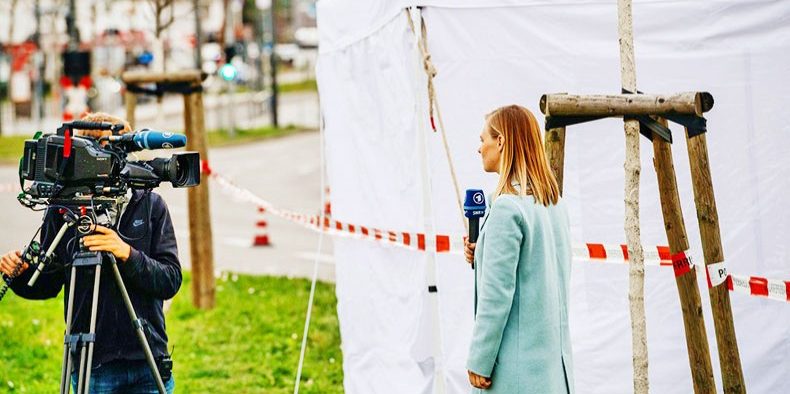WOMEN IN JOURNALISM: Twice the level of danger

Some 40 countries were identified as ‘dangerous’ for women journalists in a new report. — Open Democracy/ifeelstock/Alamy
REPORTERS Without Borders reveals the extent and type of gender-based violence against women journalists, in the field, newsroom and online.
Women journalists face significant risks of sexism and sexual violence, with 40 countries identified as ‘dangerous’ or ‘very dangerous’ for women journalists, according to a new report.
Reporters Without Borders, a non-governmental organisation committed to journalistic freedom, published its 37-page report ‘Sexism in Journalism’ on Monday, International Women’s Day. The report reveals the extent of gender-based violence against women reporters and how it impacts journalism as a whole.
Reporters Without Borders provided questionnaires in three languages to 150 correspondents and journalists in 120 countries throughout the world. Their findings are based on responses from 112 journalists, 43 per cent of whom were women.
The report defines ‘sexism’ as ‘all forms of gender-based violence, including discrimination, insults, sexual harassment, unwanted touching, verbal and physical sexual assaults, threats of rape and even rape itself’.
The field, the internet and the newsroom are all described as ‘danger zones’ for women, who are subjected to several forms of discrimination, harassment and violence. Women contend with everything from unwanted advances and groping to sexual assault and beatings. Reporters covering women’s rights, sports and politics are targeted the most, with minorities at an increased risk for violence and emotional trauma.
Christophe Deloir, secretary general of Reporters Without Borders, writes in the report’s foreword that women have to endure not only upfront dangers while in the field, but also attacks on other fronts, including online and in the newsroom. ‘It is unthinkable that women journalists should endure twice the level of danger and have to defend themselves on another front, a many-sided struggle since it exists outside the newsroom as well as inside.’
The field is among the most dangerous places for women reporters, as it takes them into volatile situations where people are unpredictable. In a ‘60 Minutes’ interview, Lara Logan, then chief foreign correspondent for CBS, described being sexually assaulted and beaten by a mob while reporting on the Egyptian revolution in 2011.
As a result of perceived dangers on the ground, women reporters often find themselves facing discrimination; about 45 per cent of respondents in the survey cited a refusal to send women to conflict zones or areas considered ‘dangerous’ as a form of gender-based discrimination.
Increase in online violence
The report also revealed that the internet has become more hazardous for women reporters than the field; 73 per cent of respondents reported that most gender-based violence occurs in online settings such as email and social media.
This includes hacking into email accounts and revealing personal information, or ‘raids’ where the person is bombarded with daily threats by groups of hackers.
In retaliation for an opinion piece, Europe 1 radio journalist Nadia Daam was sent pictures of beheadings and received threats to ‘rape her dead body’ in 2017. Syrian reporter Yakeen Bido is among the few female journalists reporting from the field to have a presence on social media. ‘I get rape and death threats every day, aimed at me and my family,’ said Bido.
Online attackers can be extremely sophisticated in their methods. They create fake social media accounts for their targets — as in the case of Indian journalist Rana Ayyubb, who was made to look like she supported child rapists. She was also a victim of ‘deepfake’ technology (often pornographic) where a person’s voice or image is doctored to appear as the attacker wants, ‘with devastating consequences’, said the report.
Some 58 per cent of respondents said that sexual violence occurs in the newsroom. What’s worse, this violence has long been tolerated as if it were simply part of the job, though recognition of it has played a major part in the advancement of the #MeToo movement. According to Reporters Without Borders, the biggest perpetrators are superiors (51 per cent) and people in positions of power (50 per cent) followed by colleagues (46 per cent).
The goal of all these attacks is to dehumanise, destroy a reputation or elicit immense fear in a woman, so that she no longer has a voice. As a consequence of gender-based harassment and discrimination among women journalists, ‘The woman self-censors and prefers to avoid mentioning certain subjects,’ reported nearly half the respondents.
In response to the report’s findings, Reporters Without Borders has made a series of recommendations for the media, governments, platforms, advertisers and women journalists.
OpenDemocracy.net, March 8. Teddy Wilson is the US investigations editor for OpenDemocracy’s Tracking the Backlash project. Joni Hess is a fellow with OpenDemocracy’s 50.50 section.










